The Benefits of Leftist Violence
Benjamin Villaroel, American Renaissance, February 25, 2017
Between the attacks against Trump supporters, thuggish protests against Milo Yiannopoulos at college campuses, and the murder of police officers by black militants, political violence appears to be here to stay. Scenes of black-clad protesters smashing windows and ATMs is frightening to Americans, but it’s common in other countries. As someone who has lived abroad, let me say that political violence is normal — and it can be useful.
The chaos in America today reminds me of time I spent in Chile — my father’s home country — during that country’s “student movement” in 2011-2012. Millennials were organizing mass protests to get the government to nationalize higher education and make it free, as in neighboring Argentina and in many European countries. At first, the movement was popular, and the sitting president, a Romney-style conservative named Sebastian Piñera, often had approval ratings of less than 30 percent.
Furthermore, higher education in Chile had been free within living memory — from the creation of the welfare state in the 1940s until the dramatic neoliberal reforms of Augusto Pinochet in the 1970s. In 2011, the student movement had the wind in its sails, and was regularly bringing out hundreds of thousands of people to march in a country of just 17 million. It seemed impossible that they wouldn’t win.
But the students did not win, and the movement ran out of gas years ago. The reasons for this are complex, but a large part of it was the fact that the moderates could not control and would not disavow the violent radicals in their ranks — and that scared away millions of potential supporters.
Without fail, every time there was a mass gathering of peaceful protesters, encapuchados (literally meaning “the hooded”), the Chilean equivalent of the “black bloc,” would show up and make trouble. Sometimes they just spray-painted anarchist symbols on public property. Sometimes they would knock down trees and set them ablaze to block traffic. Sometimes they would throw rocks and paint bombs at the police. Encapuchados and their equivalents throughout the West simply cannot resist violence and destruction “for a good cause.” Here they are in action:
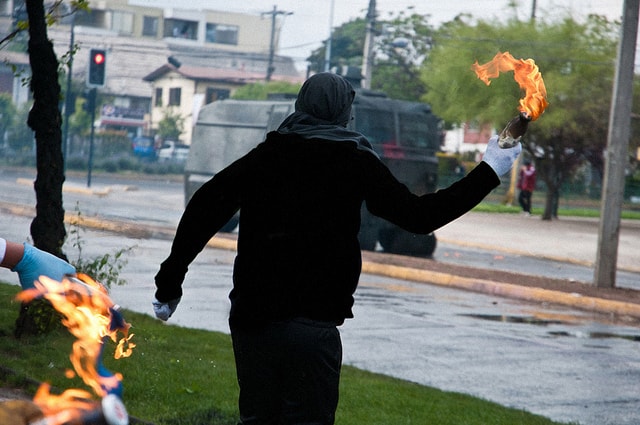
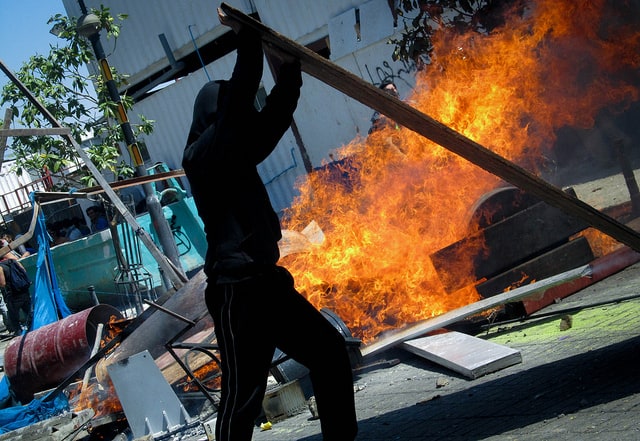
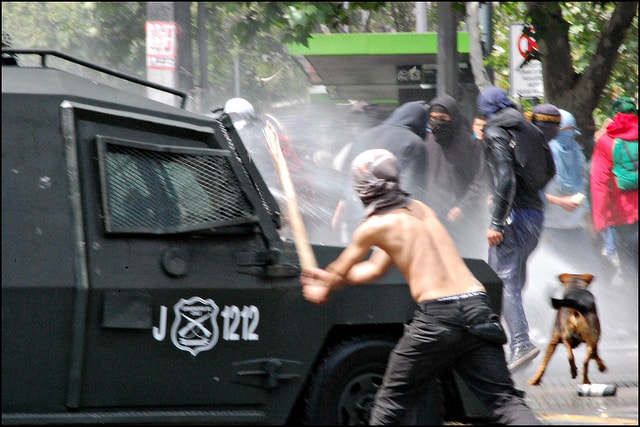
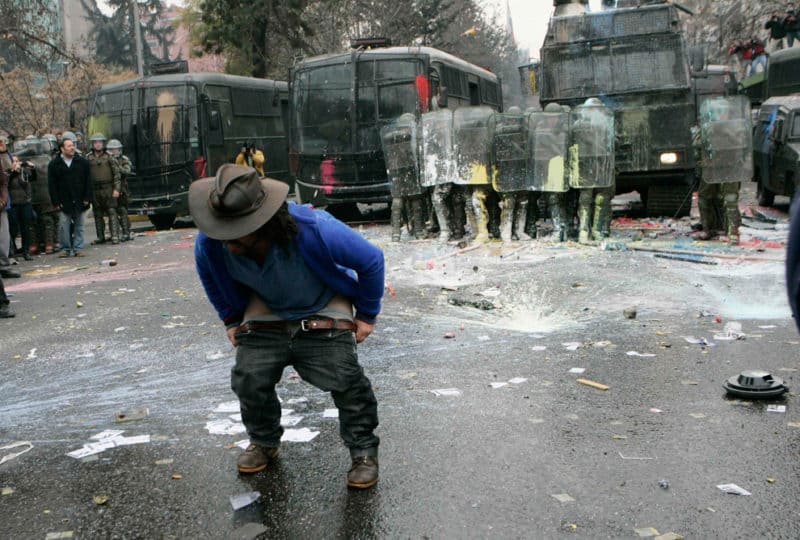
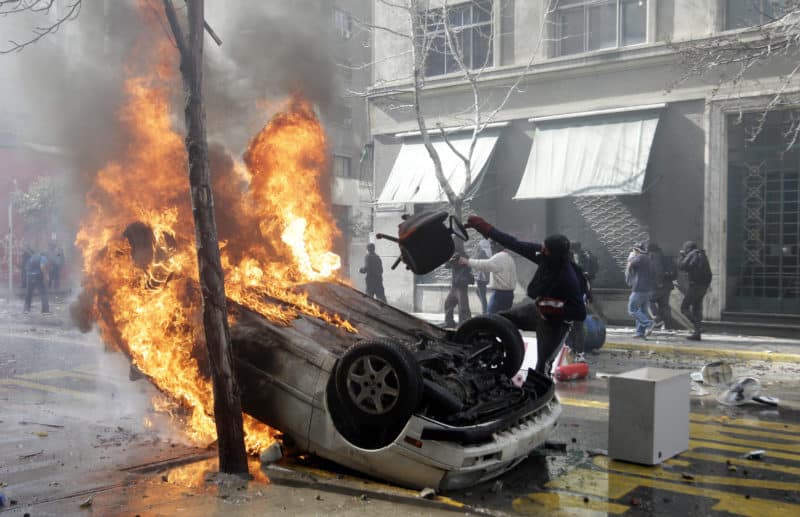
Every march came to have the same rhythm: the march would start with smiling average citizens holding up clever signs, the encapuchados would show up and start burning things, the riot police would come out, the encapuchados would get violent, the cops would use tear gas and water cannons, everyone would go home, and the nightly news would play a highlight reel of the street fights.
The overwhelming majority of protesters were not like these violent radicals. Most were polite and well-meaning social democrats. Occasionally they even faced off with encapuchados. Here’s a video of a sort of “tug of war” over whether to set up a street barricade:
And just as Robert Reich has suggested that Steve Bannon is behind the violent anti-Milo protesters, there were rumors that every other encapuchado was an undercover cop.
The movement was never able to purge the encapuchados. None of the most prominent leaders ever publicly condemned them. No proof was ever found that the troublemakers were cops. No peaceful protester ever turned an encapuchado into the police. When trouble started, the peaceful protesters wouldn’t leave the area, but stayed to watch the show — which always allowed the encapuchados to disappear back into the crowd.
Average Chileans began to associate the whole enterprise with the thugs shutting down traffic and attacking cops. When asked about the violence, leaders of militant student groups would often just shrug and say that people should empathize with how angry students were, or that citizens should put street violence in the context of larger systematic violence, or refer to the “violence” of economic inequality. Indeed, the most famous student leader, Camila Vallejo, joined Chile’s Communist Party, a group radical enough to send condolences to North Korea when Kim Jong-il died in December of 2011. Leftwing twitter accounts and blogs were full of images of encapuchados with captions lauding their efforts.
This was too much for the average citizen. Under different circumstances, working class Chilean families facing the prospect of going into debt to send their children to college would have supported this movement. Instead, they began to fear that their children might join the protests, start skipping class to brawl with the police, and ruin their lives. By the beginning of 2012, national fatigue had set in. Chileans wanted their children out of the streets and back in school. When the 2013 presidential campaign began, no serious candidate wanted to be associated with the movement.
It is not an exaggeration to say that the encapuchados kept Chile’s college system in the private sector. If the nationalization movement had not been linked to violence, it probably would have succeeded. The initial push to nationalize education in the 1940s was divorced from violence, and was successful.
America is in a similar spot today. Without the nightly news showcasing the constant violence pouring from left to right in this country, figures like Donald Trump and Milo Yiannopoulos would have considerably less sympathy. When average Americans see television images of fans of Milo and Mr. Trump being pepper-sprayed or beat-up they side with the victim of the violence. The Civil Rights movement gained enormous sympathy because of news stories of civil rights activists and “Freedom Riders” being attacked.
Most Americans (especially white ones) believe in free speech, and they don’t like seeing anyone silenced by threats or violence. Furthermore, even if they dislike Milo or Mr. Trump, the dislike the kind of people who fight the police even more.
Violence also turns the left against itself. Whenever “antifa” successfully shut down an event, or the black bloc runs amok, a handful of leftists condemn the violence. Those who condemn it are in turn condemned for condemning it. This happened to leftist polemicist Chris Hedges back in 2012 when he called black bloc “the cancer in Occupy [Wall Street].” Just about every leftist publication spent a lot of energy arguing about why he was wrong or to what degree he was wrong. More recently, after Milo was shut down at Berkeley, progressive journalist Lee Fang criticized the violent tactics the left used. He’s been arguing about the validity of his criticism ever since on Twitter. The energy the left spends devouring itself is energy not spent recruiting new adherents.
Once election season comes, Democrats will have to condemn anti-Trump violence and alienate the segment of their base that supports it or scare away moderates by being ambivalent about violence. That helps us immensely.
I suspect political violence will become more frequent and intense. If ICE starts regular raids on illegal immigrants, there are sure to be anti-ICE riots. With chaos in the streets, the Democrats will try to strike an impossible compromise between being the party of radical opposition and the party of moderate good governance, just as they did in 1968. And just as in 1968, they’ll lose. I take no pleasure in seeing photos of bloodied Trump supporters; indeed, I’ve come close to being one. But for every punch a leftist lands, our side gains a few more sympathizers.
So, two cheers for the antifa. May the fires they set illuminate our path to victory.















